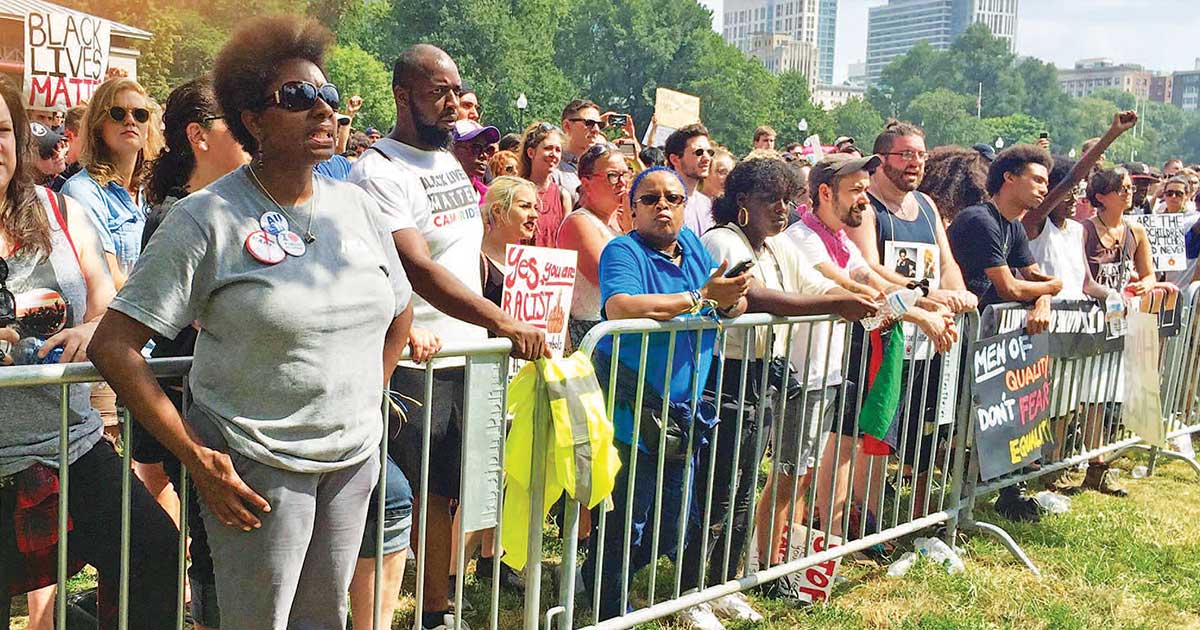MTA activism enters next phase
MTA activism enters next phase
Laura Barrett,
Communications Specialist

Last year’s wildly successful No on Question 2 campaign laid the foundation for the current state of MTA activism, while the new All In initiative is designed to take it to the next level.
Thousands of members participated in the No on 2 effort, either informally through conversations with friends and relatives or formally through phonebanking, canvassing, social media messaging and other efforts. They played a critical role in defeating the proposed charter school cap lift by a huge margin.
The challenge after any hard-won campaign is to keep the momentum going.
"We need to continue to build relationships and effective structures in our locals because that gives us power," said MTA President Barbara Madeloni.
So far, the election of President Donald Trump and appointment of U.S. Education Secretary Betsy DeVos have been strong motivators for public education advocates.
Trump administration policies helped drive thousands to the May 20 Rally for Public Education.
Backed by the MTA and other members of the Massachusetts Education Justice Alliance, the rally featured student performances, speeches, creative signs and a brass band that led MTA Annual Meeting delegates to Boston Common. The goal was not just to oppose the Trump/DeVos agenda, however.
"People in Massachusetts deeply value public education, and they deeply value the public good," said Madeloni, addressing the fired-up crowd. "When we are defending our public schools, we are defending our vision for a better world."
Anti-Trump sentiment has aided MTA member turnout at several other large events, including the Boston Women’s March for America on Jan. 21, rallies in support of immigrants and the environment, and, recently, the 40,000-strong "Fight Supremacy! Boston Counter-Protest & Resistance Rally" on Aug. 19.
The MTA recommended Worcester teacher Alexizendria Link as a speaker for that event, and she gladly obliged.
"We need to address how the residual effects of slavery cause the disparities we are seeing within the educational system," Link told the massive crowd on the Common. "A Eurocentric curriculum and implicit bias push our children of color onto the margins when they should be in the center. They are not uplifted to a place where they can learn, to a place where they are valued — and it’s time we do something different. We can start by fully funding our schools."
Link’s path to activism went through her union. She became involved with the Educational Association of Worcester for one simple reason: She was asked.
"There was no pressure," she said. "This person just said to me, ‘This might be something you are interested in.’ And I was." Since then, the high school English teacher has participated in local contract campaigns, served as a delegate to the MTA Annual Meeting and the NEA Representative Assembly, and worked to defeat Question 2.
Thomas J. "T.J." Howell, president of the Belchertown Teachers Association, agrees with Link that engaging members through face-to-face conversations is "huge."
The BTA provides a model for how activism can be channeled into local issues with the right structures in place. He and two colleagues spearheaded changes to the BTA’s communication systems after undergoing organizing training at MTA’s Summer Conference in 2016.
Another way to build power is to create stronger ties with community and labor groups. Donna Johnson, president of the 1,000-member University Staff Association at UMass Amherst, did just that in support of the USA’s campaign for respect and equitable benefits for her members.
First, they mapped their buildings to enable the local to get information to members quickly. "I’d tell a few people and then they would spread the word to other people, who would pass the message on to their designated contacts," Howell explained. "A lot of people dismiss e-mails and text messages now. Person-to-person conversations are much more effective. They don’t just spread information — they build relationships."
They used their new strategies during the Question 2 campaign, and the same structures were in place to help during a contract fight. Educator Cara Lapenas led the crisis team that planned and implemented actions and developed messages to reach out to the community.
Among other events, the team organized a toy drive and "meet and greets" with parents. At one gathering, two participants became inspired to run for the School Committee, ultimately defeating two incumbents who had not been supportive of the BTA.
Another way to build power is to create stronger ties with community and labor groups. Donna Johnson, president of the 1,000-member University Staff Association at UMass Amherst, did just that in support of the USA’s campaign for respect and equitable benefits for her members. Johnson was contacted by a group of women working for labor organizations in the Northeast who wanted to support the campaign. "I explained some of our issues," said Johnson, "like how professional staff get 26 weeks of paid maternity leave while members in our unit only get two weeks paid.
"Does the administration think it takes less time for someone in my unit to bond with a baby than someone who is a professional?" she asked.
About 150 USA supporters staged a flash mob dance and marched to the chancellor’s office, where they turned in a petition in support of the campaign. Johnson was deeply moved by the outpouring, telling the local newspaper, "I can be a tough old broad, but I was pretty emotional yesterday when people from all walks of life from all over the Northeast came here to support us."
"When we fight, we win," said Madeloni. "But we fight better and win more when we create the structures to sustain continued actions even after a crisis is averted. And we always do better when we are connected to our communities, our students and our brothers and sisters in the labor movement."
This story initially appeared in the Summer 2017 edition of MTA Today.